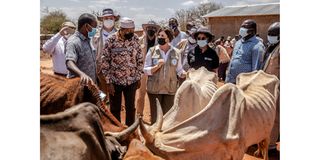Horn of Africa needs urgent help

Food and Agriculture Organization of the United Nations (FAO) Deputy Director-General Beth Bechdol visiting an emergency livestock supplements distribution center in Isiolo, Kenya.
What you need to know:
- We stand on the verge of a humanitarian catastrophe, one that could potentially push millions of people to the brink of hunger and starvation. All humanitarian and development organisations must therefore rally together to provide urgent aid.
Janez Lenarcic and Jutta Urpilainen
In 2011, a devastating drought brought the horrors of famine to the Horn of Africa. Images from the time are still seared in many people’s minds, as are the stories of those unable to access food and water in Ethiopia, Kenya, Somalia, and Djibouti.
It is because of this that the world said we must never miss the warning signs for such a tragedy again. Yet, today, another drought looms over the region. After three failed rainy seasons – and the prospect of a fourth – the risk of famine is a reality.
We stand on the verge of a humanitarian catastrophe, one that could potentially push millions of people to the brink of hunger and starvation. All humanitarian and development organisations must therefore rally together to provide urgent aid.
Lessons from a drought in 2017 in the Horn teach us that mobilising all resources is paramount to avert famine. Without further funding and support, millions will not receive the assistance they need to survive. Thousands will perish from preventable conditions.
But our ability to respond is being limited by a global funding gap. The international community’s response is not meeting growing needs across the region, especially when compared to 2017.
Nor will humanitarian assistance alone be enough to tackle this crisis. While more needs to be done to pull efforts in the short term to address the current emergency, in the longer term we must also tackle the root causes of the problem.
A dire warning
The UN has already issued a dire warning about the humanitarian situation. According to the latest estimates, nearly 20 million people need urgent food assistance throughout the region.
In Somalia alone, over 81,000 people are at the brink of famine due to the longest drought in recent history. Other countries are facing the scourge of this disaster too, with communities in Ethiopia and Kenya describing it as the “worst in a generation”.
The consequences are being felt right now. Farmers are losing their crops, livestock, and livelihoods. Families are being forced to flee their homes in a desperate search for food and water, as well as for pastures and protection.
Young boys and girls are among the most vulnerable victims of this disaster, with food and milk becoming increasingly scarce. Nearly six million children around the Horn are now facing acute to severe malnutrition.
All of this is being exacerbated by Russia’s invasion of Ukraine, and the rising prices the war has caused worldwide. Adverse weather conditions, locust infestations, and the socio-economic fallout from the COVID-19 pandemic have made matters worse.
The very real threat of famine is why the EU and the UN this week co-chaired ahigh-level roundtable in Geneva, bringing together members of the international community: donors, humanitarian partners and NGOs, and government representatives.
Our goal was to strengthen the global response and enhance international aid for vulnerable people living in the region. At the end of the discussion, the EU and its member states pledged €633 million to help fight the drought and famine.
Still, bridging the funding gap is only one challenge we are facing. Lifting impediments and restrictions blocking principled humanitarian action is another. Humanitarians must be allowed to do their job safely as they try to help the most vulnerable.
Building resilience
While we find new ways to strengthen our collective effort to address this emergency, we must also fund longer-term policies that tackle the underlying causes of food and nutrition crises and make vulnerable people more resilient to shocks. The new EU Global Gateway strategy will contribute to this work.
Climate change remains one of the greatest threats to the Horn. Many drought-affected communities are struggling to cope with the cumulative consequences of other shocks, including floods and storms.
Climate change’s negative impact in this region is bound to increase, though it could be mitigated if early warning and anticipatory response are fully integrated into humanitarian and development efforts.
Enhancing resilience in the face of food insecurity is another important step. It goes beyond emergency humanitarian aid and the immediate reorientation of development funding towards famine prevention.
The international community still has a long way to go in supporting people caught up in the middle of this drought. But we are stepping up action in the region. And we will continue to do all that is necessary to strengthen our aid funding and response.



